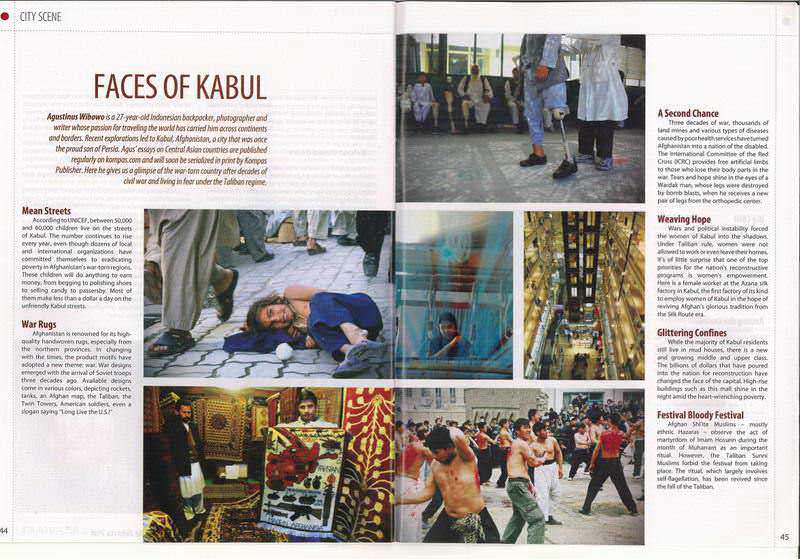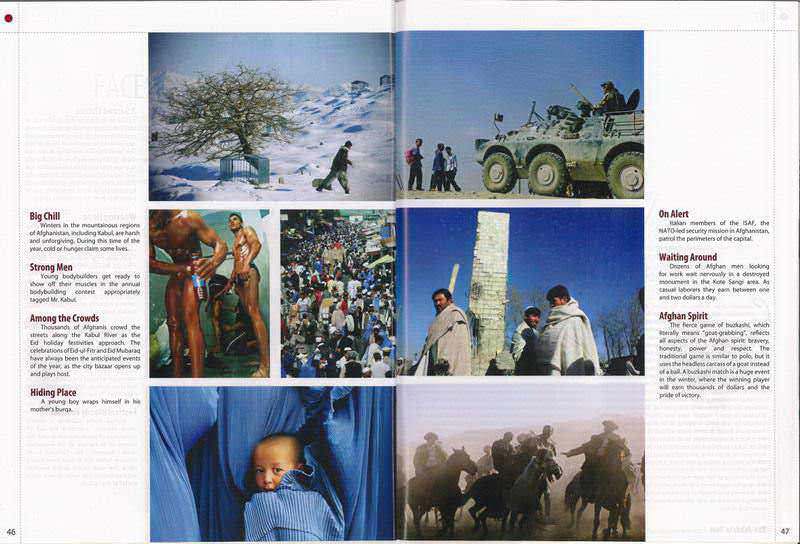Jakarta Post Weekender (2009): Face of Kabul
http://www.thejakartapost.com/news/2009/01/29/faces-kabul.html

THE WEEKENDER JAKARTA POST: Face of Kabul
The Jakarta Post – WEEKENDER | Thu, 01/29/2009 8:00 PM | City Scene
Agustinus Wibowo is a 27-year-old backpacker, photographer and writer whose passion for traveling the world has carried him across continents and borders. Recent explorations led to Kabul, Afghanistan, a city that was once the proud son of Persia. Agus’ essays on Central Asian countries are published regularly on kompas.com and will soon be serialized in print by Kompas Publisher. Here he gives us a glimpse of the war-torn country after decades of civil war and living in fear under the Taliban regime.
Mean Streets
According to UNICEF, between 50,000 and 60,000 children live on the streets of Kabul. The number continues to rise every year, even though dozens of local and international organizations have committed themselves to eradicating poverty in Afghanistan’s war-torn regions. These children will do anything to earn money, from begging to polishing shoes to selling candy to passersby. Most of them make less than a dollar a day on the unfriendly Kabul streets.
A Second Chance
Three decades of war, thousands of land mines and various types of diseases caused by poor health services have turned Afghanistan into a nation of the disabled. The International Committee of the Red Cross (ICRC) provides free artificial limbs to those who lose their body parts in the war. Tears and hope shine in the eyes of a Wardak man, whose legs were destroyed by bomb blasts, when he receives a new pair of legs from the orthopedic center.
Weaving Hope
Wars and political instability forced the women of Kabul into the shadows. Under Taliban rule, women were not allowed to work or even leave their homes. It’s of little surprise that one of the top priorities for the nation’s reconstructive programs is women’s empowerment. Here is a female worker at the Azana silk factory in Kabul, the first factory of its kind to employ women of Kabul in the hope of reviving Afghan’s glorious tradition from the Silk Route era.
Festival Bloody Festival
Afghan Shiite Muslims – mostly ethnic Hazaras – observe the act of martyrdom of Imam Hossein during the month of Muharram as an important ritual. However, the Taliban Sunni Muslims forbid the festival from taking place. The ritual, which largely involves self-flagellation, has been revived since the fall of the Taliban.

Big Chill
Winters in the mountainous regions of Afghanistan, including Kabul, are harsh and unforgiving. During this time of the year, cold or hunger claim some lives.
Glittering Confines
While the majority of Kabul residents still live in mud houses, there is a new and growing middle and upper class. The billions of dollars that have poured into the nation for reconstruction have changed the face of the capital. High-rise buildings such as this mall shine in the night amid the heart-wrenching poverty.
Hiding Place
A young boy wraps himself in his mother’s burqa.
On Alert
Italian members of the ISAF, the NATO-led security mission in Afghanistan, patrol the perimeters of the capital.
Afghan Spirit
The fierce game of buzkashi, which literally means “goat-grabbing”, reflects all aspects of the Afghan spirit: bravery, honesty, power and respect. The traditional game is similar to polo, but it uses the headless carcass of a goat instead of a ball. A buzkashi match is a huge event in the winter, where the winning player will earn thousands of dollars and the pride of victory.
War Rugs
Afghanistan is renowned for its high-quality handwoven rugs, especially from the northern provinces. In changing with the times, the product motifs have adopted a new theme: war. War designs emerged with the arrival of Soviet troops three decades ago. Available designs come in various colors, depicting rockets, tanks, an Afghan map, the Taliban, the Twin Towers, American soldiers, even a slogan saying “Long Live the U.S.!”
Waiting Around
Dozens of Afghan men looking for work wait nervously in a destroyed monument in the Kote Sangi area. As casual laborers they earn between one and two dollars a day.
Among the Crowds
Thousands of Afghanis crowd the streets along the Kabul River as the Eid holiday festivities approach. The celebrations of Eid-ul-Fitr and Eid Mubaraq have always been the anticipated events of the year, as the city bazaar opens up and plays host.
Strong Men
Young bodybuilders get ready to show off their muscles in the annual bodybuilding contest appropriately tagged Mr. Kabul.


29/06/2009 Please contact me urgently in ym.
29/06/09 contact me urgently